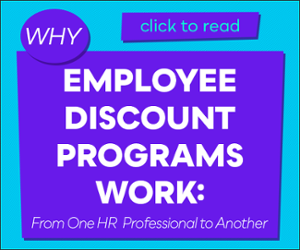Want to generate some real enthusiasm in your office to kick off the new year?
Stand up in front of all your employees, and tell them how the company is going to whip them into shape to save lots of money in the coming year.
Employees will be pumped to get off their rears and meet mandatory monthly steps and exercise mandates so that the benefits budget can be trimmed by a few hundred bucks!
We’re kidding of course. That’s how you can inspire a mutiny in your office!
Look, let’s be honest.
We all know the value of health and wellness benefits to a company. These efforts pay off through lower premiums as well as reduced absenteeism and increased productivity.
It’s a great investment!
It just so happens that none of those mean much to employees.
33% of U.S. workers say they regularly participate in employer-provided health promotion programs (American Psychological Association)
To them, a push for health and wellness can feel Big Brotherish. What business does their employer have in how they treat their bodies and what they eat or how they manage their finances?
 Why should they put in the work to change their lives just to save the company a few bucks?
Why should they put in the work to change their lives just to save the company a few bucks?
Yeah, it’s tough to push people toward health and wellness. It’s not impossible, and with the right strategy, you can actually inspire employees to go above and beyond their capabilities.
The answer? Don’t push employees into health and wellness. Open the door and make it super attractive, so they’ll walk themselves right into it.
Use these five proven tactics to get employees excited to make life changes that are going to be beneficial for them - and your company.
1. Focus on Them
Save your premium reductions and increased productivity for the boardroom. Those aren’t going to matter one iota to most employees.
Focus on what does matter: more money in their paychecks (from reduced premiums), more opportunities for promotions and raises (increased productivity), and being paid to improve life (see “Make It Fun” below).
2. Start from the Top
Most employees will only care as much as their manager needs them to. Managers will only care about something as much as their executives need them to.
When crafting your health and wellness program, don’t just get management to sign off - get them to participate. In fact, get them to make it a priority.
73% of employees with senior managers who show support through involvement and commitment to wellbeing initiatives said their organization helps employees develop a healthy lifestyle (American Psychological Association)
This isn’t just about physical fitness. Emotions roll downhill in companies and stress snowballs usually start with executives and become massive ordeals for regular employees. If mental health is a priority for your company, executives have to understand that their words and actions have major consequences down the organization chart.
3. Find Your Champions
As influential as managers are, coworkers can be just as motivating. Somewhere in your office is an employee who’s excellent at maintaining their own health and wellness. Find what they do that’s working and see if it’s replicable. If possible, even see if this employee is willing to lead some activities for their peers.
If that person goes to a Pilates class during the lunch break, chances are some fellow employees would come along - if they were only invited.
Engaged workers are 28% more likely than their actively disengaged peers to get involved in company-sponsored wellness programs (Gallup)
Even better, form a committee of employees who set the direction for the company’s health and wellness events and activities. Make sure the company knows who they are, so they can solicit ideas and feedback from their peers.
(Those people in the header image? That's our team.)
The more excited and supportive they are, the more likely their coworkers will be to follow suit.
4. Make it Fun
 Remember how cool school recess was? Right in the middle of the day you got to run around and play on school time?
Remember how cool school recess was? Right in the middle of the day you got to run around and play on school time?
That love never leaves us. We all always love being able to get away from our desks and do something - anything - other than working, while still being paid.
Organize races and pushup competitions, and let people take part while on the clock. Bring in a yoga instructor for an hour a week, mid-morning on a Tuesday. Your participation will be far higher than if you tried to organize it after hours or on weekends.
A good place to start? Not forcing them to take time off for health appointments.
60% of American workers feel uncomfortable leaving work for preventive care appointments (Zocdoc)
Yes, people away from desks has real costs to it, but...
5. Be Generous
You can put together a health and wellness effort on the cheap, if you need to.
But remember, we’re talking billions of dollars across the globe being lost to poor health. It’s not absurd to say that your company could be losing a few hundred thousand, maybe more.
Be generous. Pay for gym memberships or fitness watches. Put your logo on some fitness gear for the team. Let people get healthier while on the clock. Put out real incentives for employees who make improvements.
68% of employees would engage with their wellness program more if there were better incentives (HealthMine)
After all, a good health and wellness effort asks employees to put some skin in the game and commit to getting healthier. Shouldn’t the same be asked of the company?
Another way to be generous and increase participation: invite spouses and families to be involved. It costs more, but definitely shows commitment to the person behind the employee.
88% of employers reported improvements in health risk with spousal involvement, compared to 81% without (Mercer)
 Set the Example, Reap the Rewards
Set the Example, Reap the Rewards
You can’t force employees to be healthier and happier.
You can’t win them to your way of thinking by focusing only what’s in it for you.
You can certainly create opportunities and give them permission to improve their bodies and minds, however.
Simply adding some benefits and putting them out there won’t be enough, however.
28% of employees say their company provides gym passes, workout facilities, or wellness benefits, but 63% don't take advantage of them (CareerBuilder)
Invest in your program, both monetarily and in emotion. Build enthusiasm from the top down but also from peers.
Companies have to look at the long view of health and wellness.
Yes, people will be away from their desks. There’ll be some hard costs, too, whether you’re investing in exercise equipment or hiring a mental health coach.
It won’t take long until you start seeing the rewards, though. Eventually, it’ll become part of your culture, and your company will be known for being a place where employees are free of unnecessary stress and healthy.
And, oh yeah, it’ll definitely pay off financially for the company. Just don’t worry about stressing that to the employees.





